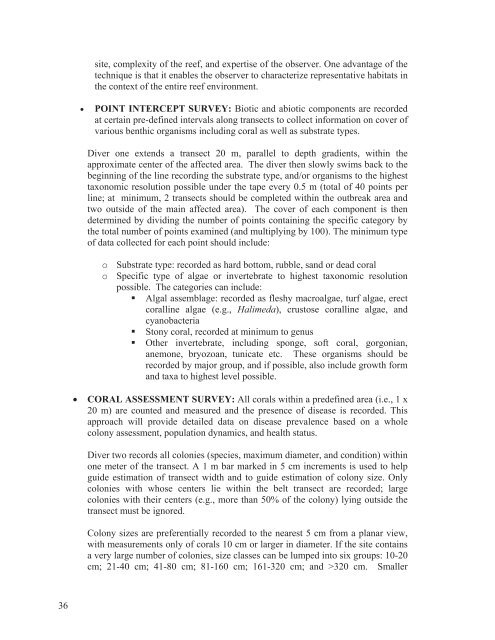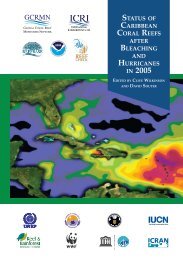site, complexity <strong>of</strong> <strong>the</strong> reef, and expertise <strong>of</strong> <strong>the</strong> observer. One advantage <strong>of</strong> <strong>the</strong>technique is that it enables <strong>the</strong> observer to characterize representative habitats in<strong>the</strong> context <strong>of</strong> <strong>the</strong> entire reef environment.POINT INTERCEPT SURVEY: Biotic and abiotic components are recordedat certain pre-defined intervals along transects to collect in<strong>for</strong>mation on cover <strong>of</strong>various benthic organisms including coral as well as substrate types.Diver one extends a transect 20 m, parallel to depth gradients, within <strong>the</strong>approximate center <strong>of</strong> <strong>the</strong> affected area. The diver <strong>the</strong>n slowly swims back to <strong>the</strong>beginning <strong>of</strong> <strong>the</strong> line recording <strong>the</strong> substrate type, and/or organisms to <strong>the</strong> highesttaxonomic resolution possible under <strong>the</strong> tape every 0.5 m (total <strong>of</strong> 40 points perline; at minimum, 2 transects should be completed within <strong>the</strong> outbreak area andtwo outside <strong>of</strong> <strong>the</strong> main affected area). The cover <strong>of</strong> each component is <strong>the</strong>ndetermined by dividing <strong>the</strong> number <strong>of</strong> points containing <strong>the</strong> specific category by<strong>the</strong> total number <strong>of</strong> points examined (and multiplying by 100). The minimum type<strong>of</strong> data collected <strong>for</strong> each point should include:o Substrate type: recorded as hard bottom, rubble, sand or dead coralo Specific type <strong>of</strong> algae or invertebrate to highest taxonomic resolutionpossible. The categories can include: Algal assemblage: recorded as fleshy macroalgae, turf algae, erectcoralline algae (e.g., Halimeda), crustose coralline algae, andcyanobacteriaStony coral, recorded at minimum to genusO<strong>the</strong>r invertebrate, including sponge, s<strong>of</strong>t coral, gorgonian,anemone, bryozoan, tunicate etc. These organisms should berecorded by major group, and if possible, also include growth <strong>for</strong>mand taxa to highest level possible.CORAL ASSESSMENT SURVEY: All corals within a predefined area (i.e., 1 x20 m) are counted and measured and <strong>the</strong> presence <strong>of</strong> disease is recorded. Thisapproach will provide detailed data on disease prevalence based on a wholecolony assessment, population dynamics, and health status.Diver two records all colonies (species, maximum diameter, and condition) withinone meter <strong>of</strong> <strong>the</strong> transect. A 1 m bar marked in 5 cm increments is used to helpguide estimation <strong>of</strong> transect width and to guide estimation <strong>of</strong> colony size. Onlycolonies with whose centers lie within <strong>the</strong> belt transect are recorded; largecolonies with <strong>the</strong>ir centers (e.g., more than 50% <strong>of</strong> <strong>the</strong> colony) lying outside <strong>the</strong>transect must be ignored.Colony sizes are preferentially recorded to <strong>the</strong> nearest 5 cm from a planar view,with measurements only <strong>of</strong> corals 10 cm or larger in diameter. If <strong>the</strong> site containsa very large number <strong>of</strong> colonies, size classes can be lumped into six groups: 10-20cm; 21-40 cm; 41-80 cm; 81-160 cm; 161-320 cm; and >320 cm. Smaller36
colonies should be identified (at least to genus) and counted within <strong>the</strong> 20 X 1 mbelt, lumping <strong>the</strong>m into colonies 0-5 cm and 6-9 cm. If <strong>the</strong>re are large numbers <strong>of</strong>small colonies, <strong>the</strong>se can be quantified by recording <strong>the</strong> total number within five 1m 2 quadrats per transect instead <strong>of</strong> surveying <strong>the</strong> entire belt. Quadrats are placednext to <strong>the</strong> transect tape at predetermined intervals (e.g., 0, 5, 10, 15, 20 m).*Note <strong>for</strong> certain areas <strong>of</strong> <strong>the</strong> Caribbean, colony sizes <strong>of</strong> 4 cm or greater mayneed to be included in <strong>the</strong> assessment.DISEASE ASSESSMENT: All colonies with disease or o<strong>the</strong>r causes <strong>of</strong> mortalityare identified and counted, and specific detailed diagnostic in<strong>for</strong>mation iscollected <strong>for</strong> those corals exhibiting signs <strong>of</strong> <strong>the</strong> disease under investigation. Thisapproach will provide data on prevalence <strong>of</strong> all diseases as well as usefuldiagnostic descriptions <strong>for</strong> <strong>the</strong> disease <strong>of</strong> interest that can assist in determiningwhen <strong>the</strong> event first occurred, how severe it is, whe<strong>the</strong>r it is ongoing, and if it isincreasing or declining in severity.Diver three identifies every colony within <strong>the</strong> one meter belt with signs <strong>of</strong> recentmortality, recording <strong>the</strong> genus and <strong>the</strong> common name <strong>of</strong> <strong>the</strong> disease or o<strong>the</strong>rcondition. This includes signs <strong>of</strong> predation (differentiated into gastropod,fireworm, COTS, or fish bites), disease, bleaching, or compromised health (e.g.,algal or invertebrate competition, physical damage etc.). For colonies exhibitingsigns <strong>of</strong> <strong>the</strong> disease under investigation, <strong>the</strong> observer should record <strong>the</strong> genus (orspecies), maximum diameter, and diagnostic features <strong>of</strong> <strong>the</strong> lesion (see section4.4.3 and Appendix IV). *If time permits accuracy may be improved by having<strong>the</strong> same diver(s) conduct <strong>the</strong> community structure surveys as well as <strong>the</strong> diseaseassessments.This same diver also identifies corals <strong>for</strong> sampling and marks <strong>the</strong>m with floatingchains and assigns temporary numbered tags. Colonies <strong>for</strong> sampling shouldinclude representatives from all species affected by <strong>the</strong> disease <strong>of</strong> interest, as wellas different stages in <strong>the</strong> progression <strong>of</strong> <strong>the</strong> disease ranging along a continuumfrom colonies that appear to be newly infected (small lesions that lack algalcolonization) to older well established infections (prominent large lesions with agradation <strong>of</strong> algal colonization on exposed skeletal surface).Depending on <strong>the</strong> site characteristics, species diversity and abundance, and extent <strong>of</strong> <strong>the</strong>disease outbreak, coral assessments or disease assessments may take additional time tocomplete. As divers finish a task, <strong>the</strong>y can assist <strong>the</strong> o<strong>the</strong>r divers by conducting coralassessment or disease assessment, beginning at <strong>the</strong> end <strong>of</strong> <strong>the</strong> transect and workingtowards <strong>the</strong> o<strong>the</strong>r divers. If <strong>the</strong> survey team consists <strong>of</strong> two divers, one diver wouldcomplete point intercept surveys and <strong>the</strong>n begin disease assessment surveys, as <strong>the</strong> coralassessment may require <strong>the</strong> most time.37
- Page 2 and 3: DisclaimerThe contents of this docu
- Page 5 and 6: PREFACECoral reefs throughout their
- Page 7 and 8: ACKNOWLEDGMENTSWe would like to ack
- Page 9: CHAPTER 4 CASE HISTORY, SAMPLE COLL
- Page 12 and 13: diseases, however, remain elusive a
- Page 16 and 17: species of interest or manifesting
- Page 18 and 19: statistically significant and biolo
- Page 20 and 21: 2.2 Regulatory AuthorityThe Respons
- Page 22 and 23: Review and assist in development of
- Page 24 and 25: familiar with such protocols, and w
- Page 26 and 27: incident operations. The IC sets pr
- Page 28 and 29: Sampling Kits: Pre-assembled kits w
- Page 30 and 31: Chapter 3Incident Command System3.1
- Page 32 and 33: 3.4 ICS Roles and Responsibilities3
- Page 34 and 35: 3.5 Establishing a Command/Operatio
- Page 36 and 37: Coral Disease Investigation Decisio
- Page 38 and 39: zooxanthellae), or completely absen
- Page 40 and 41: 3.6.4 Launching an Investigation: L
- Page 42 and 43: Chapter 4Case History, Sample Colle
- Page 44 and 45: 4.4 Survey Team- Site Identificatio
- Page 48 and 49: 4.4.3.2 Possible Modifications to C
- Page 50 and 51: 4.4.5 Field Microscopy4.4.5.1 Intro
- Page 52 and 53: 4.4.5.3 Use of Stereo MicroscopeThe
- Page 54 and 55: Collection Form, and will ferry tim
- Page 56 and 57: Due to time sensitivity of some sam
- Page 58 and 59: protein chemistry based and include
- Page 60 and 61: Tissue for Microbiology (H-B, U-B,
- Page 62 and 63: When shipping coral samples from ou
- Page 64 and 65: 4.10.2 MicrobiologyMicrobiology is
- Page 66 and 67: Chapter 5Health and Safety5.1 Safet
- Page 68 and 69: 5.4 Precautions in the FieldCoral H
- Page 70 and 71: Glossary of TermsBleaching: Loss or
- Page 72 and 73: mortality rates); the apparent occu
- Page 74 and 75: Knowlton, N. 2001. The future of co
- Page 76 and 77: 66Appendices
- Page 78 and 79: Appendix II.Level I Data - Coral Di
- Page 80 and 81: Level II Data: Coral Disease Event
- Page 82 and 83: Appendix V. Support Team Processing
- Page 85 and 86: Appendix VII.DocumentsCollection Pe
- Page 87 and 88: called a Common Main Objective (CMO
- Page 89 and 90: With reasonable care stereo microsc
- Page 91: United States Department of Commerc
















